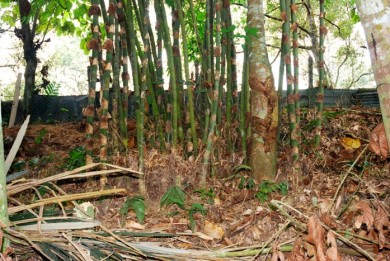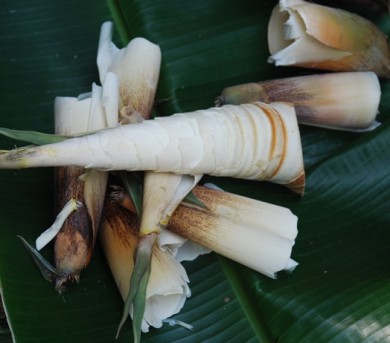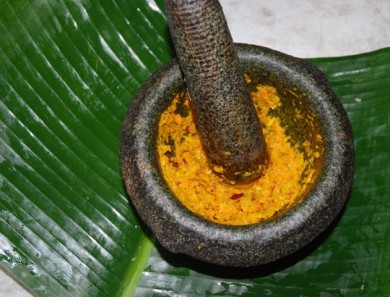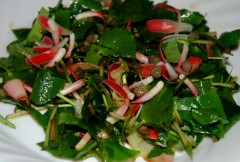Jun 01, 2012
Eat More Plants...
I am wary about juicing vegetables, especially modern vegetables. They have been hybridized to grow too fast, and too ‘sweet’ and ‘juicy’. It is like broiler chickens – they are hybridized to grow fast and to develop large breasts.
Our tests have shown a change in the nutrients content of the broiler meat due to changes in dietary requirements to meet its fast growing nutritional needs. For example, saturated fats and omega 6 content sky-rockets, making it an ‘unbalanced’ meat, whether organic or not.
The same must apply to modern hybridized vegetables and fruits. They require more nitrogen for one. What happens to all these nitrogen in the plants, and what happens to us when we consume these day in and day out? And when they grow so fast, do they really have the time to absorb all the micro-nutrients in the soil that our body needs? Again, it does not matter whether the plants are organic or not. A fast growing plant is a fast growing plant and have the same nutrient requirements, whether organic or not.
For me, plants are essential for our health. So, for juicing, I juice PLANTS, not necessarily vegetables.
Here’s a plate of leaves and flowers that I use to juice:
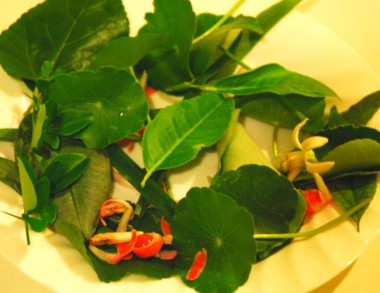
(Click on pics to enlarge)
Leaves and flowers of plants which do not contain anti-nutritional factors like oxalates, which are slow growers, which have been tested in laboratories to have high antioxidants, etc.
Here’s to your health – juice of PLANTS (not vegetables).
11:26 Posted in Blog, Slow Food / Rare Receipes | Permalink | Comments (2) | Tags: juicing of vegetables, juicing of leaves, juicing of plants, pegaga, bunga kantan, lemon flower, red ginger, cekur
Mar 20, 2012
Interesting Trees At The Farm - II
One of my favourite fruits is the Nam Nam, or katak puru (toad).
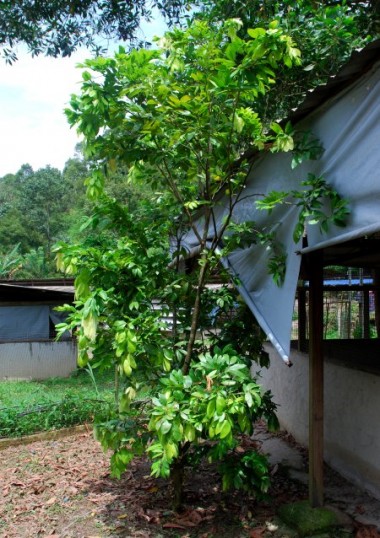
It’s a short shrubby tree, and really quite pleasing to the eye. I can picture it potted in a large pot and acting as a centre piece in a home garden.
The fruits grow on the tree trunk itself; how's that for a conversation piece!
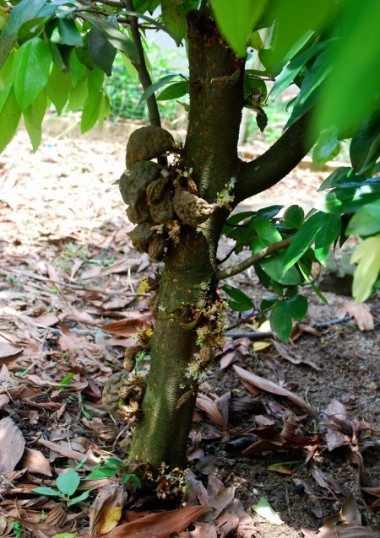
All you need to do is stoop down and pluck off ripe ones.
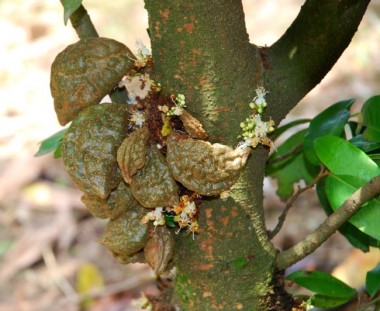
A cluster of fruits
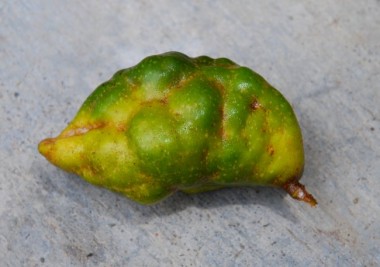
A ripe fruit
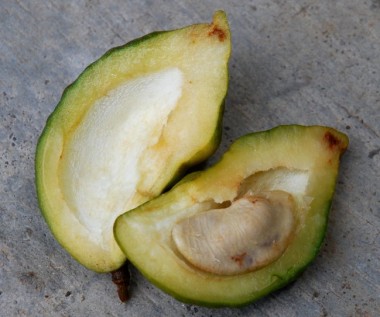
The inside of the fruit.
I like to munch it raw with skin intact. It is tart, sour, sweet, fragrant and crunchy when freshly plucked from the tree. Wait a day, and it looses its crunchiness. Kampung (village) folks say both the fruits, and the leaves made into a tea, aids in relieving kidney stones, diabetes and high blood pressure.
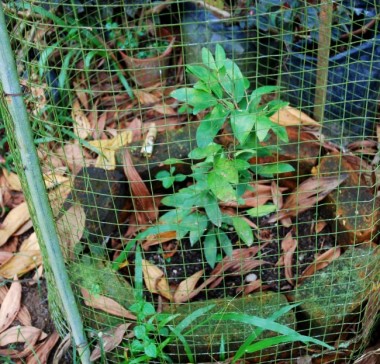
It is easily marcotted / air layered, and almost always survives planting. Nam Nam grown from seeds takes up to 6 years to fruit. I believe marcotted ones should take about a couple of years. We shall see.
18:47 Posted in Blog, Slow Food / Rare Receipes, Useful Plants | Permalink | Comments (0) | Tags: nam nam, katak puru, cynometra cauliflora, rare fruits, heritage fruits
Sep 14, 2011
The Earth Provides…
At the farm, we leave many of the original plants alone. And as you walk, you will find food almost everywhere – bamboos, banana piths, banana hearts and more.
Here's a clump of bamboo in our farm, which we can see growing wild alongside highways, in secondary forests, along village trails:
Here's some shoots we cut off from just such a clump.
Remove the outer bark and cut into thin slices.
Soak overnight, then replace the water with new water and bring to a boil. These steps will reduce or eliminate the bitter taste of the shoots.
Throw away the water and it is ready for making a gourmet dish.
Here are the main ingredients –
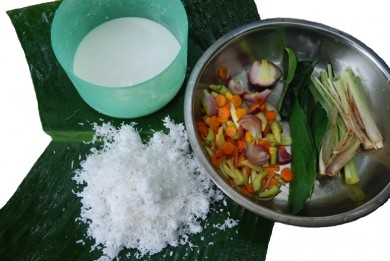
Turmeric, small onions (shallots), garlic, chillies, pound them together.
Make coconut milk from grated coconut meat.
Add serai (lemongrass), turmeric leaves and limau purut (kaffir lime) leaves and the pounded ingredients.
Put all the ingredients in the milk together and bring to a boil. Then add the bamboo shoot slices and prawns, salt and traditionally, some sugar, to taste.

Seriously yummy; the crunchiness of the shoots offset the tender prawns to make a delicious texture-filled, aromatic dish.
18:11 Posted in Blog, Permaculture, Slow Food / Rare Receipes | Permalink | Comments (0) | Tags: rebung masak lemak, bamboo shoots, slow food
Dec 07, 2009
The Internationalisation of Food
The recipes for many of our local vegetables, leaves and herbs can be 'updated' to suit modern taste-buds. This will reduce our dependence on imported fresh food or to pay high prices for transplanting those vegetables and herbs here to grow them.
Due to globalised marketing our perception of what is good and delicious food have changed, and become more 'internationalised'; leading to the possible demise of many local 'heritage' edible plants.
In the sixties and even as late as the seventies, a 'delicious' chicken was aromatic and 'sweet' just from the meat alone (of course you may have to boil the bird for an hour or so!).
Nowadays, a 'delicious' chicken means one that is tender and juicy, and the taste is from the marinate and spices used. Modern marketing have changed our perception and defination of a delicious chicken to accept the bland bird that comes out of factory farms. A bird that has excessive fats (from feeding the birds high grains diet and vegetable oils) is now spun to mean 'tender', and a bird that has both high fats and water content, is now 'juicy', never mind that it is tasteless and a nutritional disaster.
We go into a supermarket and march out with hydrophonically grown vegetables and herbs like arugulas, radicchio, etc. without realising that we have the greatest diversity of edible plants just outside our doors. They present to our senses a wide variety of aromas and tastes, far more than the western vegetables and herbs can ever deliver. And they cost a fraction of the costs of the foreign stuff.
Just go to the pasar tani (farmer's market) and look at the number of 'ulams' (plants that can be eaten raw) to choose from.
And upgrade them to modern taste-buds.
Here's an example from our farm:
Pluck a few young leaves from a lemon tree.
Take some petals from a kantan flower.
And a generous helping of pegaga (gotu kola) with the stalks ( crunchy ).
I like to cut them up to slices. Then add some balsamic vinegar, generous amount of extra virgin olive oil, some himalayan rock salt (less sodium) and pepper. And if you are a bit adventurous, add one passion fruit and some 'dijonaise' (dijon mustard and mayo, half/half) - that's real gourmet stuff we have here, courtesy of yours truly.
There will be an explosion of flavours and fragrances that will rival any on offer in a 5-star hotel.
18:54 Posted in Slow Food / Rare Receipes | Permalink | Comments (0) | Tags: slow food, kantan, pegaga
Apr 19, 2009
Rare Receipes - Durian Flowers
 Durian flowers are delicious with a subtle taste and smell. It can be eaten raw as a salad with some sambal belacan. When eaten raw, the whole flower can be eaten - the petals, stamen, pistil and sepal. The sepal is sweet with a tinge of bitterness.
Durian flowers are delicious with a subtle taste and smell. It can be eaten raw as a salad with some sambal belacan. When eaten raw, the whole flower can be eaten - the petals, stamen, pistil and sepal. The sepal is sweet with a tinge of bitterness.
The flowers are delicious stir-fried with prawns, calamari, or shell fish , with chicken pieces, with tofu. When stir-frying, use only the petals, stamen and pistil. Do not use the sepal which turns acrid when heated.
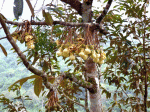
Make sure you get your flowers from an organic farm such as DQ Farm as during flowering season conventional farms will use a fair bit of weedicide and fungicide.
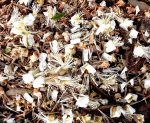

Parts of the durian flower. The sepal is sweet when eaten raw but turns acrid when cooked.
Simple Yet Delicious
Quickly immersed flowers in boiling water, remove and drain. When cool, serve with sambal belacan.
Stir-fried with Calamari - spicy
Blend onions, garlic and fresh red chillies. Stir-fry in some oil until fragrant. Add prawns or calamari, salt and some sugar to taste. If desired some belacan can be added. Add flowers for a few quick stirs, and serve. Yummy.
 Stir-fried with Prawns
Stir-fried with Prawns
Chop onions and garlic. Stir-fry until fragrant. Add prawns, salt and sugar. Add flowers, stir fry quickly, serve. For those prefering a bit of spiciness, add chopped chilli padi as garnish.
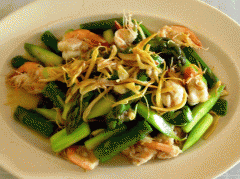
Stir-fried asparagus with prawns, oyster sauce and of course, durian flowers.
20:53 Posted in Slow Food / Rare Receipes | Permalink | Comments (0) | Tags: durian, flowers, slow food, rare receipes
Apr 17, 2009
Rare Receipes - Lontong Daun Pisang Sematu

'LONTONG' done traditionally is rarely found nowadays; at least in the cities. Some people are using plastic bags and green coloring! Before the traditional way is lost forever, here's the method:
Use only leaves from the banana plant called 'sematu' or 'batu' or 'nipah'. Using leaves from this banana cultivar will impart a deep green color to the rice and a wonderful fragrance. Leaves from other banana cultivars can be used but the color will be lacking, and the aroma is not as fragrant. Try to get leaves from an organic farm as fungicides are used extensively in banana cultivation especially if they are using tissue-cultured clones.

The 'sematu' fruit is mottled, untidy and is 3-sided and angled.
The 'sematu' banana plant is tall, at our farm it reaches to 20 feet high. We grow the plant to provide shade for the chickens in the fields. The fruit tastes better fried or cooked and is seldom eaten raw.

The 'heart' or male flower of the 'sematu' at our farm is big, easily 18 inches long.
Use 2 or 3 layers of the leaves. Use a narrow cylinder as a mould and roll the leaves. Make sure the overlap errs on the generous side so that the expanding rice will not cause the ends of the leaves to open up. Remove the mould. Close one end of the rolled leaves with tooth picks or if you intend to keep the lontong for a few days, stitch it up.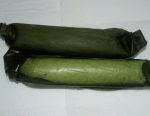 This is to prevent the rice during storage, from going moldy by exposure to air.
This is to prevent the rice during storage, from going moldy by exposure to air.
The 'sematu' leaf gives a rich green color to the cooked rice which should be glutinous-like after cooking and no longer seperates into individual grains.
Fill the rolled leaves to 30% to 40% of its length with rice. You may have to try out one cylinder first as different rice have different expansion rates. You want the rice to expand and get 'compressed' within the rolled leaves. Secure the other end.
Put the rolls into a stainless steel pot and boil for 3 to 4 hours. Do not use an aluminum pot as the greenish color will be faint due to some reaction with the leached aluminum. Take out the lontong and let drain. After it has cooled, serve. Kept in a cool dry place, it can keep for 3 days. Kept in the refrigerator it can keep for up to 10 days.
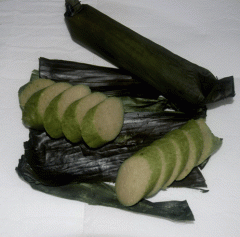
Serve with curries, with rendang, or with Chinese stews, for example those with chicken or goat pieces stewed with black soya sauce, mushrooms, garlic and herbs. Another interesting dish is lontong with grated coconut and gula melaka or palm sugar.
22:27 Posted in Slow Food / Rare Receipes | Permalink | Comments (0) | Tags: slow food, lontong, pisang sematu, pisang batu, pisang nipah

















